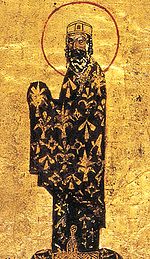Battle of Levounion
| Battle of Levounion | |||||||
|---|---|---|---|---|---|---|---|
| Part of the Komnenian restoration | |||||||
 Painting of Alexios I, from a Greek manuscript in the Vatican library. |
|||||||
|
|||||||
| Belligerents | |||||||
| Byzantines, supported by Cumans, Vlachs, Bulgarians and Frankish and Flemish mercenaries. | Pechenegs | ||||||
| Commanders and leaders | |||||||
|
Alexios I Komnenos George Palaiologos Constantine Dalassenos |
Unknown | ||||||
| Strength | |||||||
| 20,000 Byzantines 40,000 Cumans 5,000 Vlachs 500 Flemish mercenaries |
80,000 Pechenegs | ||||||
| Casualties and losses | |||||||
| Unknown | Unknown, but thought to be extremely heavy | ||||||
The Battle of Levounion was the first decisive Byzantine victory of the Komnenian restoration. On April 29, 1091, an invading force of Pechenegs was crushed by the combined forces of the Byzantine Empire under Alexios I Komnenos and his Cuman allies.
On August 26, 1071, a Byzantine army under Romanos IV Diogenes was defeated by the Seljuk Turks at Manzikert in eastern Asia Minor. The defeat caused the emperor to be deposed and replaced by the ineffectual Michael VII Doukas, who refused to honour the treaty that had been signed by Romanos. In response, the Turks began to move into Anatolia in 1073, meeting no opposition. Chaos reigned as the empire's resources were squandered in a series of disastrous civil wars. Thousands of Turkoman tribesmen crossed the unguarded frontier and moved into Anatolia. By 1080, an area of 78,000 square kilometres (30,000 sq mi) had been lost to the empire. It is almost impossible to overestimate the significance of these events, as within less than a decade more than half of the manpower of the empire had been lost, along with much of its grain supply. Thus the battle of Manzikert resulted in the greatest blow to the empire in its 700 years of history.
It is against this backdrop of defeat and disaster that Alexios Komnenos, a successful young general who had been fighting against the Turks since the age of fourteen, ascended the throne on Easter Sunday, April 4, 1081. According to John Julius Norwich, the significance of Alexios' rise to power was that "...for the first time in over half a century the empire was in capable hands." Alexios determined to restore the fortunes of the Byzantine Empire, whatever the cost. Around 1090 or 1091, Emir Chaka of Smyrna suggested an alliance with the Pechenegs in order to completely destroy the Byzantine Empire.
In the spring of 1087, news reached the Byzantine court of a huge invasion from the north. The invaders were Pechenegs from the north west Black Sea region; it was reported that they numbered 80,000 men in all. Taking advantage of the precarious situation of the Byzantines, the Pecheneg horde headed towards the Byzantine capital at Constantinople, plundering the northern Balkans as they went. The invasion posed a serious threat to Alexios' Empire, yet due to years of civil war and neglect the Byzantine military was unable to provide the emperor with enough troops to repel the Pecheneg invaders. Alexios was forced to rely on his own ingenuity and diplomatic skill to save his empire from annihilation. He appealed to another nomadic tribe, the Cumans, to join him in battle against the Pechenegs.
...
Wikipedia
